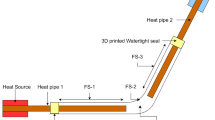Abstract
Due to the large degree of freedom in terms of design and installation, flexible ventilation ducts are commonly used in ventilation systems. However, excessive use of flexible ducts may lead to greater pressure drop and higher energy consumption. This study conducted experimental measurements to characterize the pressure drop in flexible ventilation ducts with different compression ratios and bending angles. This investigation first measured the pressure drop in straight flexible ducts with four compression ratios under various airflow rates. The calculated friction factor for the straight flexible ducts was negatively associated with the compression ratio. Next, the pressure drops in single-bend flexible ducts with various bending angles from 30° to 150° were measured under various airflow rates. The calculated loss coefficient of the bend increased with the bending angle for single-bend flexible ducts. Finally, the influence of the intermediate duct length on the pressure drop across two bends was experimentally investigated. When the length of the intermediate duct was greater than eight times the inner diameter, the pressure drop across a double-bend flexible duct could be calculated from the friction factors and loss coefficients with a relative error less than 1%. The data obtained in this study can be used to calculate the total pressure loss in flexible ventilation ducting systems in buildings.
Similar content being viewed by others
References
Abushakra B, Walker IS, Sherman MH (2004). Compression effects on pressure loss in flexible HVAC ducts. HVAC&R Research, 10: 10–275.
Agirman A, Cetin YE, Avci M, Aydin O (2020). Effect of air exhaust location on surgical site particle distribution in an operating room. Building Simulation, 13: 13–979.
ASHRAE (2005). ASHRAE Handbook—Fundamentals, Table 1. Atlanta: American Society of Heating, Refrigerating and Air-Conditioning Engineers.
ASHRAE (2017). ASHRAE Standard 120-2017: Method of testing to determine flow resistance of Hvac ducts and fittings. Atlanta: American Society of Heating, Refrigerating and Air-Conditioning Engineers.
Brown GO (2002). Henry Darcy and the making of a law. Water Resources Research, 38: 38–1.
Chen H, Cai WJ, Chen C (2016a). Model-based method for testing, adjusting and balancing of HVAC duct system. Energy and Buildings, 126: 126–498.
Chen C, Zhang X, Groll E, McKibben A, Long N, et al. (2016b). A method of assessing the energy cost saving from using an effective door closer. Energy and Buildings, 118: 118–329.
Culp C, Cantrill D (2009). Static pressure losses in 12″, 14″, and 16″ non-metallic flexible ducts with compression and sag. ASHRAE Transactions, 115(1): 622–628.
Culp C (2011). HVAC flexible duct pressure loss measurements. ASHRAE Research Project RP-1333 Final Report.
Du X, Wei A, Fang Y, Yang Z, Wei D, et al. (2020). The effect of bend angle on pressure drop and flow behavior in a corrugated duct. Acta Mechanica, 231: 231–3755.
Gibbs DC, Idem S (2010). Measured and predicted pressure loss in corrugated spiral duct. ASHRAE Transactions, 116(2): 380–386.
Griggs EI, Swim WB, Henderson GH (1987). Resistance to flow of round galvanized ducts. ASHRAE Transactions, 93(1): 3–16.
Griggs EI, Khodabakhsh-Sharifabad F (1992). Flow characteristics in rectangular ducts. ASHRAE Transactions, 98(1): 116–127.
Hodges RK, Kulkarni D, Idem S (2013). Pressure loss in fully stretched nonmetallic flexible duct with a bend. HVAC&R Research, 19: 19–87.
Huebscher RG (1948). Friction equivalents for round, square and rectangular ducts. ASHVE Transactions, 54: 54–101.
Kokayko M, Jolton J, Beggs T, Walthour TS, Dickson B (1996). Residential Ductwork and Plenum Box Bench Tests. IBACOS Burt Hill Project 95006.
Kulkarni D, Khaire S, Idem S (2009). Pressure loss of corrugated spiral duct. ASHRAE Transactions, 115(1): 28–34.
Kulkarni D, Idem S (2015). Loss coefficients of bends in fully stretched nonmetallic flexible ducts. Science and Technology for the Built Environment, 21: 21–413.
Liu W, You R, Chen C (2019). Modeling transient particle transport by fast fluid dynamics with the Markov chain method. Building Simulation, 12: 12–881.
Mutlu M (2020). Numerical investigation of indoor air quality in a floor heated room with different air change rates. Building Simulation, 13: 13–1063.
Mylaram NK, Idem S (2005). Pressure loss coefficient measurements of two close-coupled HVAC elbows. HVAC&R Research, 11: 11–133.
Nalla AN, Idem S (2012). Laboratory testing of saddletap tees to determine loss coefficients. ASHRAE Transactions, 118(1): 1131–1145.
Ojima J (2017). Decline of the performance of a portable axial-flow fan due to the friction and duct bending loss of a connected flexible duct. Journal of Occupational Health, 59: 59–210.
Pan Y, Lin C-H, Wei D, Chen C (2019). Experimental measurements and large eddy simulation of particle deposition distribution around a multi-slot diffuser. Building and Environment, 150: 150–156.
Paruchuri A, Idem S (2018). Experimental comparison of pressure loss in typical flexible and sheet metal residential duct systems. ASHRAE Transactions, 124(2): 102–115.
Salehi M, Sleiti AK, Idem S (2017). Study to identify computational fluid dynamics models for use in determining HVAC duct fitting loss coefficients. Science and Technology for the Built Environment, 23: 23–181.
Sun Y, Ford SE, Zhang Y (2015). Laboratory testing of flat oval transitions to determine loss coefficients (RP-1606). Science and Technology for the Built Environment, 21: 21–386.
Townsend B, Khodabakhsh-Sharifabad F, Idem S (1996). Loss coefficient measurements for flat oval elbows and transitions. ASHRAE Transactions, 102(2): 159–169.
Weaver K, Culp C (2007). Static pressure losses in nonmetallic flexible duct (6″, 8″, and 10″). ASHRAE Transactions, 113(2): 400–405.
Acknowledgements
This work was partially supported by the Early Career Scheme of Research Grants Council of Hong Kong, China (No. 24208518, No. 25210419) and the National Natural Science Foundation of China (No. 51708474).
Author information
Authors and Affiliations
Corresponding author
Rights and permissions
About this article
Cite this article
Dai, H.K., Huang, W., Fu, L. et al. Investigation of pressure drop in flexible ventilation ducts under different compression ratios and bending angles. Build. Simul. 14, 1251–1261 (2021). https://doi.org/10.1007/s12273-020-0737-8
Received:
Revised:
Accepted:
Published:
Issue Date:
DOI: https://doi.org/10.1007/s12273-020-0737-8




